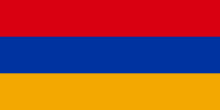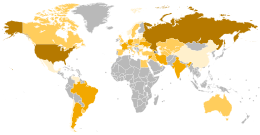ชาวอาร์มีเนีย
ชาวอาร์มีเนีย (อาร์มีเนีย: հայեր) เป็นกลุ่มชาติพันธุ์ที่เป็นประชากรหลักในประเทศอาร์มีเนีย และยังมีชุมชนชาวอาร์มีเนียในประเทศเพื่อนบ้าน เช่น ประเทศจอร์เจีย ประเทศอิหร่าน ประเทศรัสเซีย ประเทศยูเครน ฯลฯ เหตุการณ์การฆ่าล้างเผ่าพันธุ์ชาวอาร์มีเนียทำให้ชาวอาร์มีเนียอพยพไปยังหลายประเทศทั่วโลก เช่น ประเทศฝรั่งเศส สหรัฐ ประเทศอาร์เจนตินา ฯลฯ
Հայեր | |
|---|---|
 | |
| ประชากรทั้งหมด | |
ป. 7[1]–10 ล้านคน[2]
 | |
| ภูมิภาคที่มีประชากรอย่างมีนัยสำคัญ | |
| ชาวอาร์มีเนียพลัดถิ่น | |
| 1,182,388[5]–2,900,000[6] | |
| 1,000,366[7]–1,500,000[8] | |
| 250,000[9]–750,000[10] | |
• | 168,191[11] 41,864[12] |
• | 146,573[13] |
| 150,000[14] | |
| 120,000[15] | |
| 90,000–110,000[16] | |
| 100,000[17] | |
| 99,894[18] | |
| 100,000[19][20] | |
| 80,000[21] | |
| 70,000[22] | |
| 60,000[23] | |
| 55,740[24] | |
| 50,000[25] | |
| 25,000 | |
| 16,723 | |
| 8,000–10,000 | |
| ภาษา | |
| อาร์มีเนีย | |
| ศาสนา | |
| ส่วนมาก: คริสตจักรอัครสาวกอาร์มีเนีย, คริสต์นิกายโรมันคาทอลิก, คริสต์นิกายโปรเตสแตนต์ ส่วนน้อย: ความเชื่อพื้นเมือง | |
ชาวอาร์มีเนียเป็นชนชาติแรก ๆ ในโลกที่นับถือศาสนาคริสต์ และเป็นประเทศแรกในโลกที่นับถือศาสนาคริสต์เป็นศาสนาประจำชาติ โดยที่ศาสนจักรของอาร์มีเนียไม่ได้ขึ้นตรงหรือมีความเกี่ยวข้องกับคริสตจักรโรมันคาทอลิกแต่อย่างใด
อ้างอิง แก้
- ↑ different sources:
- Dennis J.D. Sandole (24 January 2007). Peace and Security in the Postmodern World: The OSCE and Conflict Resolution. Routledge. p. 182. ISBN 9781134145713.
The nearly 3 million Armenians in Armenia (and 3–4 million in the Armenian Diaspora worldwide) "perceive" the nearly 8 million Azerbaijanis in Azerbaijan as "Turks."
- McGoldrick, Monica; Giordano, Joe; Garcia-Preto, Nydia, บ.ก. (18 August 2005). Ethnicity and Family Therapy, Third Edition (3 ed.). Guilford Press. p. 439. ISBN 9781606237946.
The impact of such a horror on a group who presently number approximately 6 million, worldwide, is incalculable.
- Sargsyan, Gevorg; Balabanyan, Ani; Hankinson, Denzel (1 January 2006). From Crisis to Stability in the Armenian Power Sector: Lessons Learned from Armenia's Energy Reform Experience (illustrated ed.). World Bank Publications. p. 18. ISBN 9780821365908.
The country's estimated 3–6 million diaspora represent a major source of foreign direct investment in the country.
- Arthur G. Sharp (15 September 2011). The Everything Guide to the Middle East: Understand the people, the politics, and the culture of this conflicted region. Adams Media. p. 137. ISBN 9781440529122.
Since the newly independent Republic of Armenia was declared in 1991, nearly 4 million of the world's 6 million Armenians have been living on the eastern edge of their Middle Eastern homeland.
- Dennis J.D. Sandole (24 January 2007). Peace and Security in the Postmodern World: The OSCE and Conflict Resolution. Routledge. p. 182. ISBN 9781134145713.
- ↑ different sources:
- Von Voss, Huberta (2007). Portraits of Hope: Armenians in the Contemporary World. New York: Berghahn Books. p. xxv. ISBN 9781845452575.
...there are some 8 million Armenians in the world...
- Freedman, Jeri (2008). The Armenian genocide. New York: Rosen Publishing Group. p. 52. ISBN 9781404218253.
In contrast to its population of 3.2 million, approximately 8 million Armenians live in other countries of the world, including large communities in the America and Russia.
- Guntram H. Herb, David H. Kaplan (2008). Nations and Nationalism: A Global Historical Overview: A Global Historical Overview. Santa Barbara, California: ABC-CLIO. p. 1705. ISBN 9781851099085.
A nation of some 8 million people, about 3 million of whom live in the newly independent post-Soviet state, Armenians are constantly battling not to lose their distinct culture, identity and the newly established statehood.
- Robert A. Saunders, Vlad Struko (2010). Historical dictionary of the Russian Federation. Lanham, Maryland: Scarecrow Press. p. 50. ISBN 9780810854758.
- Philander, S. George (2008). Encyclopedia of global warming and climate change. Los Angeles: SAGE. p. 77. ISBN 9781412958783.
An estimated 60 percent of the total 8 million Armenians worldwide live outside the country...
- Robert A. Saunders, Vlad Strukov (2010). Historical dictionary of the Russian Federation. Lanham, Maryland: Scarecrow Press. p. 51. ISBN 9780810874602.
Worldwide, there are more than 8 million Armenians; 3.2 million reside in the Republic of Armenia.
- Von Voss, Huberta (2007). Portraits of Hope: Armenians in the Contemporary World. New York: Berghahn Books. p. xxv. ISBN 9781845452575.
- ↑ [1] เก็บถาวร 7 มกราคม 2019 ที่ เวย์แบ็กแมชชีน հոկտեմբերի 12-21-ը Հայաստանի Հանրապետությունում անցկացված մարդահամարի արդյունքները (The results of the census conducted in October 2011 in the Republic of Armenia). pp 6-7. (ในภาษาอาร์มีเนีย)
- ↑ Ministry of Culture of Armenia "The ethnic minorities in Armenia. Brief information" เก็บถาวร 10 ตุลาคม 2017 ที่ เวย์แบ็กแมชชีน. As per the most recent census in 2011. "National minority" เก็บถาวร 16 กุมภาพันธ์ 2017 ที่ เวย์แบ็กแมชชีน.
- ↑ "National makeup of the population of the Russian Federation (Национальный состав населения Российской Федерации)" (ภาษารัสเซีย). Russian Federal State Statistics Service. เก็บจากแหล่งเดิมเมื่อ 5 January 2016. สืบค้นเมื่อ 5 January 2013.
- ↑ Robert A. Saunders, Vlad Struko (2010). Historical dictionary of the Russian Federation. Lanham, Maryland: Scarecrow Press. p. 50. ISBN 978-0-8108-5475-8.
- ↑ Total ancestry categories tallied for people with one or more ancestry categories reported 2011 American Community Survey 1-Year Estimates. United States Census Bureau. สืบค้นเมื่อ 22 December 2012.
- ↑
- Milliken, Mary (12 October 2007). "Armenian-American clout buys genocide breakthrough". Reuters. เก็บจากแหล่งเดิมเมื่อ 5 November 2013. สืบค้นเมื่อ 5 December 2012.
- "Barack Obama on the Importance of US-Armenia Relations". Armenian National Committee of America. 19 January 2008. เก็บจากแหล่งเดิมเมื่อ 6 January 2013. สืบค้นเมื่อ 24 July 2012.
- ↑ Thon, Caroline (2012). Armenians in Hamburg: an ethnographic exploration into the relationship between diaspora and success. Berlin: LIT Verlag Münster. p. 25. ISBN 978-3-643-90226-9.
- ↑ Taylor, Tony (2008). Denial: history betrayed. Carlton, Victoria: Melbourne University Pub. p. 4. ISBN 978-0-522-85482-4.
- ↑ "National Statistics Office of Georgia" (PDF). คลังข้อมูลเก่าเก็บจากแหล่งเดิม (PDF)เมื่อ 5 February 2017. สืบค้นเมื่อ 24 May 2016.
- ↑ В Абхазии объявили данные переписи населения. Delfi (ภาษารัสเซีย). 29 December 2011. เก็บจากแหล่งเดิมเมื่อ 28 July 2019. สืบค้นเมื่อ 20 August 2013. (According to the 2011 census).
- ↑ Republic of Artsakh. "Population estimates of NKR as of 01.01.2013". เก็บจากแหล่งเดิมเมื่อ 21 May 2020. สืบค้นเมื่อ 20 February 2014.
- ↑ Gibney, Matthew J. (2005). Immigration and asylum: from 1900 to the present. Santa Barbara, California: ABC-CLIO. p. 13. ISBN 978-1-57607-796-2.
- ↑ Vardanyan, Tamara (21 June 2007). "Իրանահայ համայնք. ճամպրուկային տրամադրություններ" [The Iranian-Armenian community]. Noravank Foundation. เก็บจากแหล่งเดิมเมื่อ 19 May 2020. สืบค้นเมื่อ 5 January 2013. (ในภาษาอาร์มีเนีย).
- ↑ Sargsyan, Babken (8 December 2012). "Գերմանիաիի հայ համայնքը [Armenian community of Germany]". เก็บจากแหล่งเดิมเมื่อ 3 March 2016. สืบค้นเมื่อ 10 January 2015. (ในภาษาอาร์มีเนีย).
- ↑ "The Virtual Museum of Armenian Diaspora". Ministry of Diaspora of the Republic of Armenia. คลังข้อมูลเก่าเก็บจากแหล่งเดิมเมื่อ 19 February 2014. สืบค้นเมื่อ 2014-02-19.
- ↑ The 2001 census Ukrainian census held in 2001 เก็บถาวร 31 ตุลาคม 2004 ที่ เวย์แบ็กแมชชีน
- ↑ Comunidade armênia prospera no Brasil, mas não abandona luta pela memória do massacre เก็บถาวร 10 มิถุนายน 2016 ที่ เวย์แบ็กแมชชีน. By Breno Salvador. O Globo, 24 April 2015
- ↑ "Federal Senate of Brazil Recognizes Armenian Genocide". Armenian Weekly. 3 June 2015. เก็บจากแหล่งเดิมเมื่อ 14 July 2015. สืบค้นเมื่อ 12 May 2016.
- ↑ Bedevyan, Astghik (18 January 2011). "Հունաստանի հայ համայնքը պատրաստվում է Հայաստանի նախագահի հետ հանդիպմանը [Armenian community of Greece preparing for the meeting with the Armenian president]". Radio Free Europe/Radio Liberty Armenian Service. เก็บจากแหล่งเดิมเมื่อ 3 March 2016. สืบค้นเมื่อ 10 January 2015. (ในภาษาอาร์มีเนีย).
- ↑ Ayvazyan 2003, p. 100.
- ↑ "Foreign Ministry: 89,000 minorities live in Turkey". Today's Zaman. 15 December 2008. เก็บจากแหล่งเดิมเมื่อ 20 May 2011. สืบค้นเมื่อ 5 January 2013.
- ↑ Canada National Household Survey, Statistics Canada, 2011, เก็บจากแหล่งเดิมเมื่อ 24 December 2018, สืบค้นเมื่อ 20 August 2013. Of those, 31,075 reported single and 24,675 mixed Armenian ancestry.
- ↑ "Narodowy Spis Powszechny 2011 (Polish Census of 2011)". Główny Urząd Statystyczny (Polish Central Statistical Office). 2011. คลังข้อมูลเก่าเก็บจากแหล่งเดิมเมื่อ 17 October 2015. สืบค้นเมื่อ 31 October 2015.
บรรณานุกรม แก้
- The categorization of Armenian churches in Los Angeles used information from Sacred Transformation: Armenian Churches in Los Angeles a project of the USC School of Policy, Planning, and Development.
- Some of the information about the history of the Armenians comes from the multi-volume History of the Armenian People, Yerevan, Armenia, 1971.
แหล่งข้อมูลอื่น แก้
- FACES Project - Armenian population worldwide เก็บถาวร 2009-02-08 ที่ เวย์แบ็กแมชชีน
- Armenian Videos from Armenia and Diaspora เก็บถาวร 2021-03-01 ที่ เวย์แบ็กแมชชีน
- A long way from Ararat... Little Armenias int Europe and the Mediterranean. Marseille's Armenians เก็บถาวร 2015-04-17 ที่ เวย์แบ็กแมชชีน